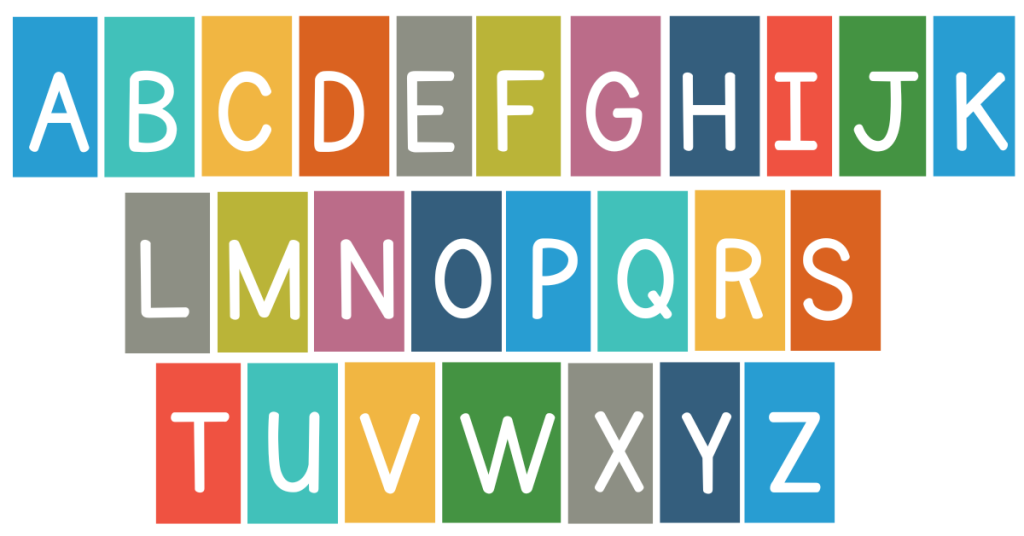Excellent Ways to Teach Letter Discrimination to Kids
In the exciting journey of nurturing a child’s literacy skills, fostering letter knowledge is a crucial milestone. In the latest installment of our series on letter knowledge skills, we delve into engaging and effective activities designed to enhance children’s ability to discriminate between different letters of the alphabet.

Welcome to our post on effective strategies for honing letter discrimination skills in young learners! Understanding letter discrimination is an important piece of the puzzle when it comes to decoding, which requires applying the proper sounds to the correct letters of the alphabet.
What is Letter Discrimination?
Letter discrimination is the art of distinguishing one letter from another due to differences in shape and orientation, and for young learners just starting their journey into the world of letters, it can be a fascinating yet puzzling adventure.
Some letters, especially lowercase letters, can be tricky for little ones. Take for example letters ‘b’, ‘d’ and ‘p’, ‘q’, which are mirror images of each other, or ‘n’, and ‘u’, which are inversions of each other. To young eyes, these seemingly similar characters can be a source of confusion.
In this blog post, we’re going to explore activities designed to enhance letter discrimination skills and provide valuable visual aids to help avoid letter confusion.
Letter Discrimination Activities
Difficulty in discriminating between letters can contribute to reading and writing challenges. Early intervention through letter discrimination activities can help prevent and address some areas of potential difficulties.
Practicing letter discrimination through games, sorting activities, and hands-on experiences can help children avoid confusion, which ultimately helps improve their future reading and writing fluency.
These activities are all great ways to help your little one(s) learn to decipher the shapes, sizes, and unique qualities of print letters that help distinguish one letter from another. These activities also help children get comfortable with letters and develop a positive attitude toward their letter knowledge learning.
Alphabet Puzzles

Use alphabet puzzles with interlocking pieces that children can fit together to form letters. These are great hands-on tools for helping children learn differences between the shapes of letters, practice their fine motor skills, learn letter names, and can even provide an opportunity to practice their colours too!
Which One Doesn’t Belong

Create or print out worksheets where your child has a row of letters, all the same except for one. Your child’s job is to indicate which one is the odd one out and doesn’t belong.
Alternatively, you could use letter stickers, tiles, magnets, or other letter manipulatives for this activity.
Letter Find Activity

Write out or lay out some letters, working with either uppercase or lowercase letters. Add 4-5 of the same letter within the mix of letters. Then show your little learner the letter to look for and either circle or collect.
Can your little one find them all?
Guess the Letter On Your Back!

The brilliance of this activity is you can do this simple activity anywhere and anytime! Simply draw letters on your little one’s back. It’s perfect for when you’re waiting in line or for an appointment.
It also helps your child learn the stroke patterns and sequences when forming letters. You’ll want to start with capital letters first.
Below are some helpful tips for how to best approach this activity for children just starting to learn their letters.
How to Play:
You might do a few letters each night before bedtime or during bath time and work your way up through the alphabet slowly.
Ox & Owl Literacy
Letter Art: Decorating or Fill-In Letter Shape Activities

Help your little one learn letter shapes by filling in the letter outline using stickers, bingo dappers, pompoms, tissue paper, glitter glue, or other smaller craft items.
Alphabet Sorting Activity

Sort letters into three different groups: one group with letters made up of only straight lines; one with letters containing only curved lines; and one with letters made up of both curved and straight lines.
Letter Shape Lacing

Simply cut out the letters using thicker paper or cardboard, or you might laminate some letters. We suggest doing this with the letters in your child’s name. Next, punch holes along the outside lines and have your little one do some lacing practice with thread.
Sensory Letter Shape Tracing

Provide sandpaper letters or other types of textured letter cards, that children can trace with their fingers, feeling the shape and texture of each letter.
This is great for those tricky letters… and numbers, like the number eight.
Letter Pattern Recognition

Can your little learner figure out what the next letter shape should be to complete the pattern?
Why not help your little one practice their letter shape recognition skills while also building their pattern recognition abilities at the same time?
Letter Creature Creations

Creating letter creatures is also fun!
Simply cut out letters to turn into animals and other creatures that start with that letter sound. For example, turn the letter ‘Ss’ into a snake, add spikes to the letter ‘Dd’ to make a dinosaur, turn an ‘Mm’ into a monster, or the letter ‘Zz’ into a black and white striped zebra.
Choose uppercase or lowercase letters, depending on what you are working on with your little learner(s).
Letter Stamping and Stenciling

Stamping letters onto paper or instead stamping ink-free onto playdough or kinetic sand is great for practicing orienting the letters the correct way… maybe to spell out a simple three-letter word or your child or student’s name.
Depending on your child’s fine motor skill level, stenciling offers another great way to reinforce orientation and letter shapes. It can help to tape the stencil down with masking tape.
Air Writing

Have your child or student write the letter in the air as they say the letter. Pairing movement with vocalizing helps increase connections in the brain that build retention.
Alphabet Car Race Tracks

Encourage your little one to race along letter racecar tracks! As they drive along the tracks, why not recite letter formation poems to help your child master which strokes to do and in which order? Do a short little work session together, then let your little learner play and drive their cars whichever way they please.
Letter Cookie Creations

Bake some tasty letter cookies by using letter cookie cutters with your little one. Reinforce letter shape discrimination by having your child decorate the cookies.
Letter Construction Activities

Have your child create tactile letters by using playdough and playdough letter mats or by using alphabet construction sets.

Vocabulary Quest
Word: Snuggle
Meaning: to get cozy with someone or something you love, like giving a big, warm hug or cuddling up with a soft blanket or stuffed animal.
Ex: All the penguins waddled into a group huddle, declaring it a “snuggle shuffle” to stay warm on the ice.

Curious Queries Corner?
Stir up your learner’s imagination and create some conversation and connection by asking an unusual question.
Would you rather have spaghetti hair you can eat anytime or rainbow fingers that change colors when you wiggle them?
Letter Reversals: Tips & Tricks to Reduce Confusion
Letter discrimination is particularly important in addressing common issues like letter reversals. As little learners embark on their path to deciphering letters, tricky print letters prone to reversals (e.g., ‘b’ and ‘d’) and inversions (e.g., ‘m’ and ‘w’) may appear as puzzling roadblocks. By honing their skills with discriminating letters apart, children can overcome confusion and write and read with greater accuracy.
Below is a collection of teaching tricks, which are essentially a visual toolkit designed to help your child or students with these tricky letters and avoid confusion.
Banishing ‘b’ and ‘d’ Confusion: Top Tricks

Start with the bat shape (the straight vertical line from top to bottom) followed by the ball shape (the curve at the bottom). Did you notice the words bat and ball both start with the letter sound /b/?
This visualization technique is a great way for children to remember the shape and order of strokes to form the lowercase ‘b’.

The straight vertical line on the right of the letter ‘b’ is similar to the frame of a bed, and the straight vertical line on the letter ‘d’ on the opposite side (left side) is like the foot of the bed.
Get your little one to physically make these hand shapes (which are the American Sign Language (ASL) letter shapes) to help them visualize the bed.

When writing ‘b’ and ‘d’, start with the picture you see. For the lowercase letter ‘b’, start with the bat, drawing a line from top to bottom first. For the lowercase letter ‘d’, start with the dolphin diving, drawing the curved line first.
Through consistent motor repetition in forming the letters, children can better distinguish these letters apart and write the correct letter they mean to write.
Upside-Down Letters: Visual Aids to Conquer Inversions




Visual Aids for Other Troublesome Letters

Imagine the lowercase letter ‘q’ as a monkey wearing a crown. She is the queen monkey of the jungle who’s sometimes seen with a straight tail and sometimes with a curled tail hanging below the leaves of the tree.

To help remember which stroke to make first when writing the letter ‘p’, think of the straight line of the letter ‘p’ as a paddle. To remember that the straight line of the lowercase letter ‘p’ dips below the writing line, think of the paddle going into the water.

Imagine the straight line of your letter ‘h’ as a horse holding its head up nice and high touching the sky. If your line is too short, it might be confused with the lowercase letter ‘n’.
Other Visual Strategies for Letter Mastery

Assign different colors to each letter. For instance, use blue for the lowercase ‘L’ and purple for the uppercase letter ‘I.’ This visual distinction can help kids remember which letter is which.

Try these visual aids to help your little learner(s) remember the 5 lowercase letters of the English alphabet that hang below the writing line.

Lowercase letter ‘g’: A little goblin that likes to hide underground.
Lowercase letter ‘j’: A j-hook being lowered into the water to catch a fish.
Lowercase letter ‘p’: A paddle going into the water to move and steer the punt (boat).
Lowercase letter ‘q’: A queen monkey with a tail hanging below the leaves of the tree, whose tail is sometimes curled and sometimes straight.
Lowercase letter ‘y’: A yew tree with deep roots below the ground.
Embarking on the journey through the alphabet with our young learners is both thrilling and, at times, a bit perplexing. The visual aids shared here serve as tools to aid in conquering common challenges, such as letter reversals, inversions, and other sources of confusion.
Letter Knowledge Series
Did You Know?
Did you know there are five letter knowledge components in preschool and kindergarten literacy instruction? Letter discrimination skills are one of these five components. All five are important skills that need to be taught and practiced to help young learners develop reading and writing readiness.
Five Components of Letter Knowledge:
Letter Recognition
Letter
Order
Letter
Discrimination
Letter-Sound
Correspondence
Letter
Formation
Other Letter Knowledge Related Posts
Key OOliteracy Takeaways
Nurturing Little Minds, Sparking Big Dreams

I’m happy you’re here!
Hi, I’m Julie, the passionate creator of Ox & Owl Literacy. I enjoy empowering families and educators with wonderful resources to inspire fun, imaginative, and joyful learning opportunities for young kiddos. You’ll find lots of recommended books, reading resources, and creative learning activities on this site aiming to help children fall in love with language, books, reading, and the transformational power of stories.



















